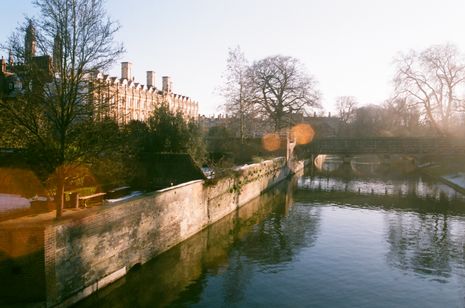How phosphate infiltrates the Cam
Will Brammer takes a deep dive into the ecology of high phosphate levels in the River Cam

Most of us have heard about the controversies of Cam water at some point. Raw sewage overflow into the river, potentially apocryphal stories from friends about illness for days after falling in, and far too high phosphate levels. But what does that actually mean? Why is phosphate in such high concentrations in the Cam? And why is it a problem for the health of the river?
Phosphate is an ion – a tiny, charged particle – which has been measured for some time in the Cam. This work has largely been carried out by the Cam Valley Forum (CVF), a volunteer group concerned with the quality of the water in the river. They have tested phosphate concentrations at various points along it, and as a previous Varsity article has reported, the results are concerning. Recent CVF recordings from some points in the river have revealed phosphate levels of up to 3.18mg/L. For context, the Water Framework Directive, an EU directive setting goals for water quality, sets bounds of greater than 1.089mg/L as being bad quality.
“The real issue comes with the potentially catastrophic environmental concerns”
These levels occur through the use of fertilisers, which contain phosphates that can run off from fields and into rivers, but also from sewage emissions. These emissions have high phosphate concentrations due to the ion’s presence in human excrement, as well as from industrial effluents and household cleaning products. This is a major issue in the Cam’s case, as concerns about sewage negligence have been raised by various groups.
But why is this a big deal in the first place? After all, phosphate levels aren’t associated with any real human risk for ingestion (though they do imply that swimming there would be just downstream of sewage overflow points). The real issue, instead, comes with the potentially catastrophic environmental concerns.
Remember how phosphates were used in fertilisers? There’s an important reason for that – it’s an essential nutrient for many things, including DNA synthesis, which helps plants grow faster. This is the problem – when this phosphate gets into rivers, rapid plant algal growth, termed eutrophication, has major ecological effects.
At first glance, of course, eutrophication in rivers doesn’t seem like a major issue. After all, plant growth is usually seen as a good thing – it can act as food for animals in the water, and potentially increase overall oxygen levels. The issue iswith moderation. It’s a general rule in ecology that any massive growth of one species is unlikely to have good overall effects.
“With a lot of hard work the river’s health can be kept in good condition yet”
When phosphate levels increase, algal blooms – rapid growths of algae numbers in response to these high nutrient concentrations – are common. In fact, these blooms regularly grow so thick that they block light from getting to lower plants, having adverse effects on species living in deeper waters. Bacteria then have a great source of food in these decaying plants, so their numbers increase rapidly, and so their overall oxygen consumption does, too. Therefore, oxygen levels in the water can quickly become far too low – far from the usual perception of plant growth! And with that, the death of many animals in the river.
And the issues don’t stop there. The entire balance of plants and animals in the river can be thrown out of balance by a small change like this. A particular concern in the River Cam, the Cam Valley Forum believes, is the threat of invasive species such as Floating Pennywort.
Floating Pennywort is a plant non-native to the UK that was banned from sale in 2014. While previously favoured as decorative pond plants in gardens, it rapidly found its way into the natural ecosystem and began reproducing out of control. With a growth rate of 20cm per day under optimal conditions, the invasive species can outcompete native species, blocking water flow and depleting oxygen levels. The fact that it can also grow back from tiny fragments makes it very difficult to remove when it takes root.
So, with damage to the river’s ecosystem coming from all these angles and more, is there any hope at all? Yet there has been undeniable progress; the CVF, after spending five years voluntarily devoting time manually pulling out Floating Pennywort in the upper Cam, believes they have managed to eradicate the invasive species from this area completely. While progress on tackling the problem at its root cause of sewage work negligence should always be the goal, it is a testament to the importance of the river to many people that at least some of the effects of high phosphate levels and ecological damage have been kept at bay. With a little luck, a lot of hard work, and some major change in the policies of sewage works, the river’s health can be kept in good condition yet.
 News / Clare Hall spent over £500k opposing busway 24 December 2025
News / Clare Hall spent over £500k opposing busway 24 December 2025 News / Caius mourns its tree-mendous loss23 December 2025
News / Caius mourns its tree-mendous loss23 December 2025 Comment / The ‘class’ of Cambridge24 December 2025
Comment / The ‘class’ of Cambridge24 December 2025 Comment / Yes, I’m brown – but I have more important things to say22 December 2025
Comment / Yes, I’m brown – but I have more important things to say22 December 2025 Interviews / Politics, your own way: Tilly Middlehurst on speaking out21 December 2025
Interviews / Politics, your own way: Tilly Middlehurst on speaking out21 December 2025










